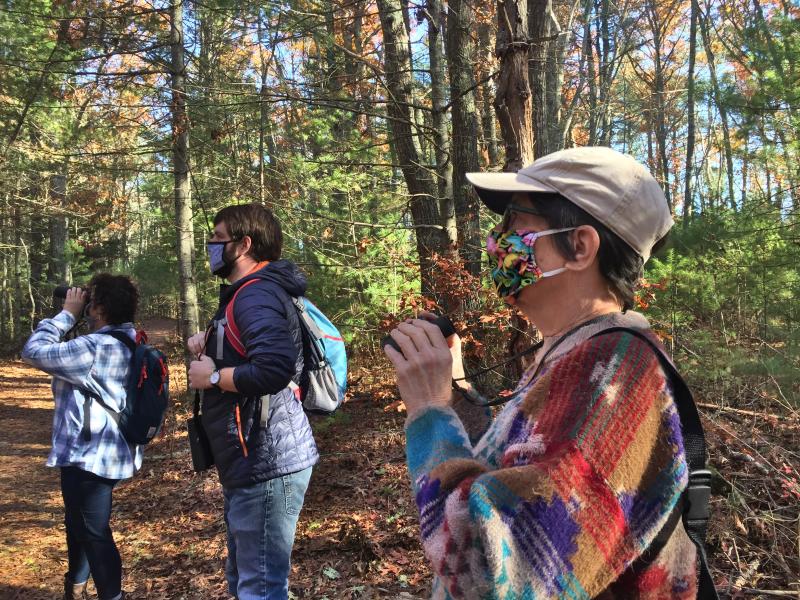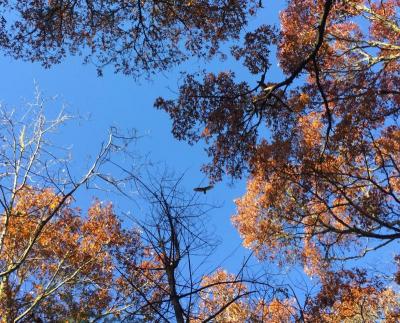For the birds: Local birdwatchers find some feathered friends
How many dees would a chickadee dee if a chickadee could chick dees?
According to wildlife biologist Andrew Single, the number of “dee”s in a chickadee’s signature warning call depends on the perceived threat level: five signifies a threat, and after that the longer the call, the higher the threat.
Single gave out this and other bits of bird-related trivia to a small flock of birdwatchers at a Buzzards Bay Coalition-led walk through Destruction Brook Woods on Monday morning.
The hobbyist birders joined the expedition as part of the coalition’s Bay Adventures program.
Coalition communications director Michael Graca noted at the start of the walk that the program aims to create opportunities for people outdoors.
“That’s part of our mission, which is to engage people in the outdoors and to appreciate all of the natural resources we have in this area, which really are phenomenal,” he said.
Several participants — armed with binoculars, cameras, and in some cases, snacks — wandered the woods listening for bird calls as Single described the wide variety of species found in New England fields and forests.
With more than 500 species of birds found in Massachusetts — many of which can have up to five or six different calls, he noted — there is a wide range of vocalizations to learn.
“It’s an impossible library of noise to know,” Single said.
He noted that on an earlier walk through Destruction Brook, he found 11 species of birds just in the first stretch of trails.
Smaller birds like chickadees and titmice are generally less solitary, and are often found in clusters with a variety of species — so just listening for their distinctive calls can lead birders to the group.
Those on the walk came from all over the South Coast.
Sherri Roberts of Plymouth said she originally got into birdwatching due to a hobbyist colleague.
“I just like nature in general, so it was just learning more about what’s around me,” she said.
Bourne native Nim Nimtuck said her interest in birds started when she moved to the area from Boston.
“Our city bird was pigeon,” she laughed. “When I was able to have the space to put up a bird feeder, I got interested in identifying what was there, because it was all new to me.”
“I enjoy being outside, and because I’m inquisitive, I like to know what I’m looking at,” she added.
Nimtuck said that she likes to walk along the canal in Bourne and watch the ducks — particularly the “phenomenal” plumage of Eider ducks. “They’re beautiful,” she said.
New Bedford resident Lorene Sweeney said that she has been into birdwatching her whole life.
“I like the different ways they adapt to their environment,” she said. “I love to listen to their songs.”
Birds seen and heard on the day included a downy woodpecker, an American robin, a brown creeper, a turkey vulture, and plenty of bluejays — the bullies of the bird world, according to Single.
“If they’re bullying a hawk, little birds will join in,” he said. “If they’re bullying the little birds, no one’s joining.”
Single noted that the number of bird species in North America is currently declining at an alarming rate due to the use of pesticides — even regular lawn pesticides can build up in birds consuming lots of insects with minimal toxins — and loss of habitat.
Many birds need continuous forests or green spaces to thrive, he said. And human disturbances can really throw them for a loop.
“There was this big fireworks display, and when all the fireworks went off, some of our infrared satellites were actually able to pick up on the heat signature of all the birds that flushed in the middle of the night,” he said. “So it was this mass of thousands of birds just jumping out of nests.”
“A lot of them ended up dying because of it,” he added.
Single said he originally got into biology and birds due in part to a childhood love of dinosaurs. “Birds are dinosaurs,” he noted with a laugh.
He added that his favorite bird is the black-throated blue warbler, a bird he set a goal of finding when he first became a biologist.
“I think they’re just super pretty birds,” he said. “On top of them being my favorite to look at, I think they’re really cool to watch. It’s just kind of like a personal achievement for me, because I did — I finally found one.”




















